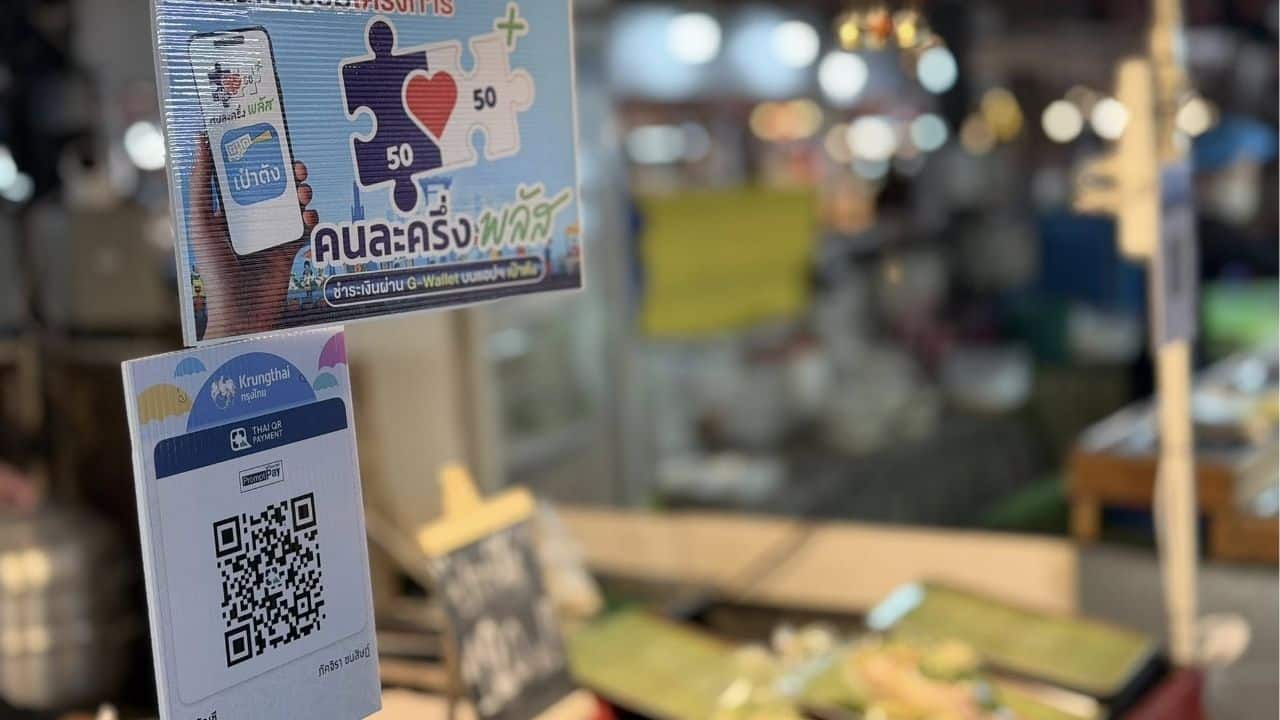The expat’s guide to QR payments in Thailand: How to actually pay for street food
A few ways you can go cashless in Thailand with or without PromptPay

The Thaiger key takeaways
- Most Thai QR codes use PromptPay, but only merchant QR codes accept foreign banking apps; personal QR codes used by food stalls and taxis don’t.
- Expats can pay using three methods: open a Thai bank account, use a cross-border app (for merchant QR), or reimburse a Thai friend.
- Thailand’s move toward a cashless society is growing fast, but carrying some cash is still essential for street-level transactions
In Thailand’s cash-light economy, QR code payments are everywhere, from boutique cafes and malls to the most humble roadside som tam stall. If you’re an expat or a long-term visitor trying to figure out how to pay digitally without a Thai bank account, you may have discovered a frustrating truth: the system isn’t as plug-and-play as it seems.
This guide breaks down exactly how QR code payments work in Thailand, why some QR codes won’t accept your foreign card and what expats can do to pay for everyday items, including street food, without relying on cash.
QR codes are everywhere but they don’t all work the same

Thailand’s fast adoption of QR code payments is built around a system called PromptPay. Almost every Thai bank, vendor, and mobile wallet supports this standard. But here’s the catch: not all QR codes are created equal.
You’ll mostly encounter two types of QR codes:
- Merchant QR codes – Issued by banks or official payment processors (like KBank or Krungthai), these codes are tied to a business account and support cross-border QR payments.
- Personal PromptPay codes – These are tied to an individual’s phone number, citizen ID, or bank account, and do not accept foreign payment apps or bank cards.
Street food stalls, market vendors, taxis, and small businesses often use Personal PromptPay QR codes. This means that your Alipay, WeChat Pay, or foreign bank’s QR system is likely to be rejected, unless it’s connected to a local Thai bank account.
Why foreign cards don’t always work with Thai QR codes
Even if your foreign banking app supports QR payments, it may not be compatible with PromptPay unless it’s part of the ASEAN cross-border QR payment scheme. At present, this network includes banks and e-wallets in:
- Singapore (via PayNow, DBS, UOB, OCBC)
- Malaysia (via DuitNow, Touch ‘n Go)
- Indonesia
- Vietnam
- Laos
- Cambodia
These systems only support payments to Merchant QR codes, not the personal PromptPay codes you’ll find taped to most street food carts. That’s why your DBS or UOB app might work at a Bangkok cafe, but not at a grilled chicken vendor in Chiang Mai.
The problem: Most QR codes are personal, not merchant
In practice, street-level Thailand is still built around person-to-person (P2P) QR codes, the kind that only accept domestic payments. These are usually set up by vendors themselves using their phone number or national ID linked to their bank.
These personal codes are incompatible with foreign cards or overseas QR payment apps.
If you’ve ever tried to pay for mango sticky rice with a QR scan from your Alipay, only to have the payment fail or be rejected, this is why.
So, what actually works?
%20EN?ts=1761814803264&dpr=off)
There are a few realistic options for expats, digital nomads, and long-stay visitors to pay for street food, groceries, or taxi rides using QR codes, without breaking Thai banking regulations or depending solely on cash.
Here are three practical solutions:
Option 1: Get a Thai bank account with PromptPay access
If you’re staying in Thailand long-term and have the proper visa, opening a Thai bank account is the most seamless way to integrate into the local payment ecosystem.
- What you’ll get: A Thai bank account linked to a PromptPay QR code, plus a mobile app with QR scan and pay functionality.
- Pros: Works everywhere, accepted by all vendors, lowest fees.
- Cons: Requires a long-stay visa (education, marriage, retirement, etc.), work permit or school letter, and sometimes proof of address.
Once set up, you’ll be able to scan and pay any PromptPay QR code, personal or merchant, using apps like K PLUS, SCB Easy, or Bangkok Bank Mobile.
Option 2: Use a cross-border payment app (only works with merchant QR)
If you’re coming from Singapore or Malaysia, your domestic banking app may already support QR payments in Thailand but only at businesses with merchant QR codes.
For example:
- DBS PayLah! or OCBC users from Singapore can pay at Thai cafes that display “Accepts Singapore QR” signs.
- Touch ‘n Go eWallet from Malaysia supports payments at selected vendors in Thailand.
This will not work at food stalls or taxis using personal PromptPay QR. It’s a limited solution for urban areas, malls, and chain stores only.
Option 3: Ask a Thai friend to pay, then reimburse in your currency
For visitors who don’t have a Thai bank account or a regional payment app, the easiest workaround is simple: have a Thai companion scan the QR code and pay, then send them your share via bank transfer or app (like Wise or Revolut).
It may not be high-tech, but this workaround is:
- Widely used among expats
- Totally legal
- Instantly effective at any vendor
It also spares you from carrying cash and sidesteps any foreign transaction fees.
But what about digital wallets like TrueMoney Wallet?

Thailand has several local digital wallets, but TrueMoney Wallet is the most widely used. It supports PromptPay and is accepted at many street vendors.
However, TrueMoney requires a Thai ID card to register. That rules it out for most tourists or new arrivals, unless you are:
- A foreigner with a Thai permanent residency card
- A migrant worker from Laos, Cambodia, or Myanmar (some of whom are eligible to use TrueMoney via special programs)
For regular expats, this isn’t a viable solution but it’s good to know why you’ll see that bright orange app everywhere.
Why this matters: Going cashless is easier, but not universal
As Thailand pushes further toward a cashless society, QR code payments are becoming the norm. But the distinction between personal and merchant QR codes creates a blind spot for international users.
Street food vendors, tuk tuk drivers, and mom-and-pop shops still rely on personal QR codes that only talk to local banking apps. Understanding this helps you avoid confusion, embarrassment, or standing in line fumbling with a useless app.
Carrying some cash in Thailand is still useful, especially in rural areas or for older vendors who don’t accept QR payments at all. But in cities like Bangkok, Chiang Mai, or Phuket, knowing how to navigate the QR system can make life a lot easier.
For long-term expats, setting up a Thai bank account unlocks full QR compatibility. For everyone else, knowing which QR codes work and who can help you pay saves time and hassle.
As 2025 rolls on, paying in Thailand is more convenient than ever as long as you know which QR code you’re scanning.
ดูโพสต์นี้บน Instagram
Latest Thailand News
Follow The Thaiger on Google News:


























